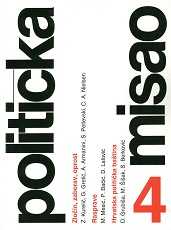Oblici vlasti u renesansi: jedinstvenost dubrovačkog modela
Forms of Power in the Renaissance: Uniqueness of the Dubrovnik Model
Author(s): Damir GrubišaSubject(s): Politics / Political Sciences
Published by: Fakultet političkih znanosti u Zagrebu
Keywords: Machiavelli; civil republicanism; Florentine “democratic” republicanism; Venetian aristocratic republicanism; Dubrovnik Republic; rector
Summary/Abstract: The author looks into the forms of political power in the Renaissance, and the typology thereof as provided by Niccolò Machiavelli in The Prince and in Discourses on Livy. The article aims to examine whether there is a differentia specifica distinguishing the Dubrovnik form of political order from similar forms of political power in Renaissance times. Republican forms of political power are analysed here, and the author stresses the existence of forms situated along the transition line from republic to principate, i.e. monarchy, and vice versa. An exposé of presuppositions of Machiavelli’s initial analysis of comparative political orders is followed by a comparative analysis of the Florentine republican model of government, the Venetian form of political power, and, finally, the Dubrovnik model of political order. Although each model had distinctive features, they were similar inasmuch as each preserved the common idea of civil republicanism (repubblicanesimo civile), and then shaped its political order in accordance with the interests of the main social and political forces in the country, i.e. in its territory. For instance, the Florentine republicanism developed into a so-called “democratic republicanism” (here the term democracy means exclusively that which Machiavelli refers to as governo dei molti – the government of many). Although such forms of wider participation of citizens in decision-making satisfied most citizens of Florence, the system was unstable, because it was subject to internal conflicts between fractions and parties, and to external pressures. The Venetian system of aristocratic republicanism was much more stable, but its social base was narrower and, ultimately, prior to its downfall, it transformed into a self-contained police system. The Dubrovnik model of political order was also a form of aristocratic republicanism, but its uniqueness lies in the fact that, unlike Venice or Genoa, it limited the authority and prerogatives of the state ruler, in this case the rector, who guaranteed the stability and non-corruption of the system. The inclusion of commoners through confraternities [bratovština] in the city’s public affairs made it possible to expand the social basis of such an order. These two characteristics also make the Dubrovnik political model unique.
Journal: Politička Misao
- Issue Year: XLVI/2009
- Issue No: 04
- Page Range: 165-182
- Page Count: 18
- Language: Croatian

